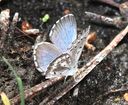Glaucopsyche
Glaucopsyche
Classification
- Phylum: Arthropoda
- Subphylum: Hexapoda
- Class: Insecta
- Order: Lepidoptera
- Superfamily: Papilionoidea
- Family: Lycaenidae
- Subfamily: Polyommatinae
- Genus: Glaucopsyche
Pronunciation
How to pronounce Glaucopsyche: //ˌɡlɔːkɔpˈsaɪkiː//
These audio files are automatically generated. While they are not always 100% accurate, they are a good starting point.
Images






Summary
Glaucopsyche is a diverse genus of butterflies commonly known as blues, found primarily in the Holarctic region. With various species adapted to different habitats, they play important ecological roles and are known for their striking appearances.
Physical Characteristics
Members of the genus Glaucopsyche exhibit the characteristic blue coloration typical of the Lycaenidae family, which varies among species; many species also show distinctive black or dark patterns on the wings.
Identification Tips
Look for small butterflies with iridescent blue upper wings and contrasting dark borders. The undersides of the wings often show a mottled pattern, which can be used for identification among species.
Habitat
Glaucopsyche butterflies inhabit a range of environments including grasslands, meadows, and edges of forests, often favoring areas where their host plants grow.
Distribution
The genus Glaucopsyche is distributed primarily in the Holarctic region, especially in Palearctic Asia and parts of North America.
Diet
Adults feed on nectar from various flowering plants, while larvae typically feed on specific host plants from the family Leguminosae (beans and peas).
Life Cycle
Glaucopsyche undergo a complete metamorphosis with distinct egg, larval, pupal, and adult stages, usually with one or two generations per year depending on the species.
Reproduction
Mating occurs in the spring and summer, with females laying eggs on the host plants suitable for the larvae.
Predators
Birds and other predatory insects typically prey on Glaucopsyche larvae and adults.
Conservation Status
Several species within the Glaucopsyche genus may be at risk due to habitat loss, with Glaucopsyche xerces being noted as extinct.
Ecosystem Role
Glaucopsyche butterflies play a role in pollination as adults while serving as food for various predators in their ecosystems.
Economic Impact
While Glaucopsyche butterflies do not have significant economic impact, they are important indicators of ecosystem health and biodiversity.
Cultural Significance
The beauty of Glaucopsyche butterflies contributes to their popularity within butterfly collecting and they often symbolize the diversity of pollinators.
Collecting Methods
- Netting in suitable habitats during flight periods.
- Attracting with nectar sources or bait traps.
Preservation Methods
- Pressing and drying specimens for display and study.
- Using collection boxes with proper climate controls to prevent damage. Looping specimens onto pins for curation.
Evolution
The genus Glaucopsyche is part of the Lycaenidae family and exhibits a rich evolutionary history with several distinct lineages that have adapted to their environments and host plants over time.
Similar Taxa
Misconceptions
Some may confuse Glaucopsyche species with other blue butterflies in the Lycaenidae family due to their similar coloration, leading to misidentification.
Tags
- butterfly
- Holarctic
- Lycaenidae
- blue butterflies
- insect diversity